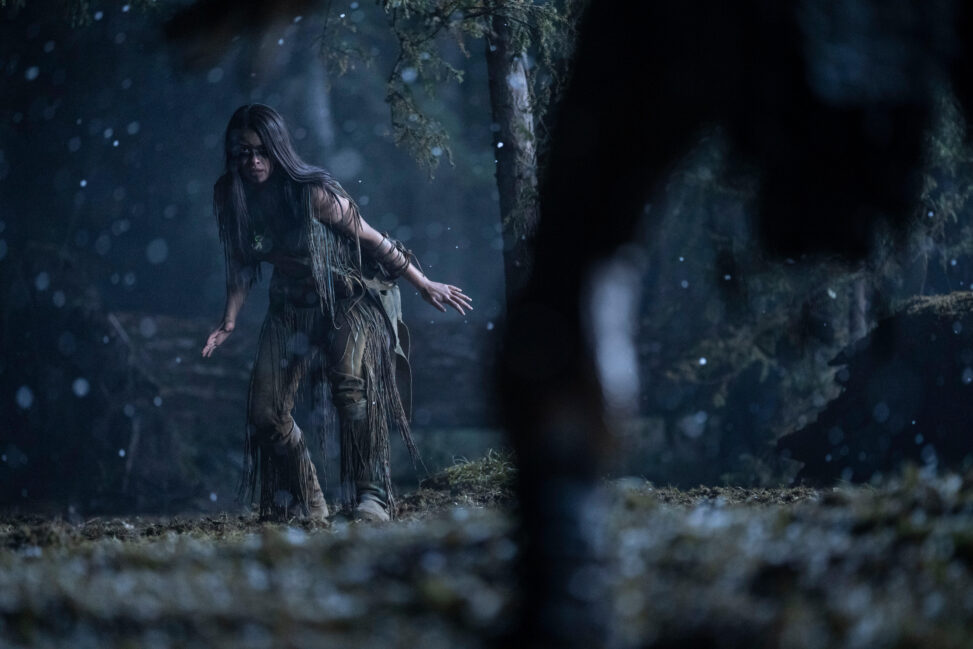Prey (2022), directed by Dan Trachtenberg, follows a young Comanche woman named Naru and explores her journey to prove herself as a hunter while rejecting the traditional role as a healer that is expected of women of her tribe. The film uses this journey to create a commentary on several themes using the act of hunting as a story-telling device to convey a deeper allegory for power, survival, and resistance. Prey (2022) foregoes the typical naming convention used by the Predator franchise to develop these themes by suggesting that the roles of the predator and the prey are blurred. Through contrasting the different approaches taken by the films’ characters to hunting, the narrative challenges what it means to be a hunter, showing how Naru’s intelligence and ability to adapt triumph over brute strength.
The Predator serves as the absolute pinnacle of hunting in the film, an alien whose unnatural strength and otherworldly technology act as the unattainable standard that the other hunters are compared to. It doesn’t hunt for survival, but for dominance, for the sport of testing itself against the most dangerous lifeforms it can find in the universe. In Naru’s first encounter with the Predator, the alien kills a grizzly bear that Naru failed to take down, proudly lifting the bear overhead and showering in its blood (00:45:00, Trachtenberg). The low angle shot of the camera in this scene helps establish the Predator as not just a threat but the threat, a creature that would be at very top of the earth’s food chain. Not only is the Predator powerful, but also is remarkably brutal, either skinning its prey or taking trophies of more challenging opponents as a mark of glory. Unlike other hunters in the film that rely on strategy and numbers, like the Comanche tribe or the French Hunters, the alien does not. The Predator hunts as a personal test of ability, to demonstrate its own power and skill, to accept cooperation or win through means beyond its own physical capabilities would diminish the prestige of the victory.
On the surface, the Comanche tribe and the French Hunters are similar, both using their numbers and employing strategy to their advantage in the hunt, but the similarities end upon exploring their differing values and methods. For the Comanche tribe, hunting is both necessary for survival as well as a rite of passage (traditionally reserved for men) that demonstrates skill, respect for the land, and connection to their culture. The Comanche must use their own instincts and tools from the land to overcome their prey. In contrast, profit and thrill is what drives the French hunters, showing no regard for the land the Comanche holds dear. They use advanced technology such as firearms and see the Natives as feral animals, using Naru and her brother as bait for the Predator. The film makes the viewer draw a direct comparison to the Predator and the French Hunters when Naru enters a clearing, the camera tilting upward to reveal a vast field full of skinned buffalo corpses (00:35:56, Trachtenberg). At this point of the film, the French Hunters are not introduced and even though they were the culprits, the viewer is made to falsely infer that the only thing capable of this type of brutality is the Predator itself. However, aspects from both groups are reflective parts of the Predators characterization; the Comanches reliance on their own abilities and how hunting is a rite of passage for their culture, to the French Hunters’ pursuit of supremacy, their barbarity and use of their technological dominance. Together, the two factions help form a thematic bridge between the Predator and its foil, the protagonist, Naru.
Naru’s journey intentionally subverts what the characters in the film believe a hunter should be. Much like the typical action hero trope, the hunters in Prey (2020) are men (or male adjacent) that overcome adversity through overpowering the obstacles in front of them. Whether it’s the Comanche, French Hunters, or the Predator itself, when it comes to the hunt: the strongest wins. Naru, however, doesn’t overpower anything by conventional means. Instead, she spends the film learning, using her intellect and adaptability to survive. While she is still highly skilled, her eventual victory over the Predator doesn’t come through besting it in a contest of strength, rather, creating conditions through meticulous planning that gives her an advantage unlike those that fell before her. As the Predator rises from the bog, Naru recites the mantra taught by her brother, with the camera suddenly cutting to the helmet Naru stole from the Predator. In this moment, both the audience and the Predator realize that the role of the prey was reserved this whole time (1:27:10, Trachtenberg), Naru’s victory coming from her understanding of not just the Predator, but the environment itself. While the men that had disregarded her hunting abilities because she was a woman perish, Naru survives by defeating the beast with her own type of strength. The inclusion of the human hunters and their parallels with the Predator help establish a narrative of a young woman’s resistance against the cultural expectations placed on her, and not just a run-of-the-mill human vs alien story.
While Prey (2022) doesn’t do anything revolutionary when it comes to Indigenous storytelling, particularly with Comanche culture being presented in an antagonistic role, the setting does aid in creating unique protagonist that stands out within the action genre. Through the setting and those within it, the film uses the hunt to show that Naru’s defiance isn’t rebellion but rather liberation from the societal expectations that bind her. Her victory is treated as the role of the Hunter being redefined, from an expression of domination to an act of understanding shaped by intelligence and adaptability. Unlike the typical Western action hero who prevails through brute force, Naru’s power comes from belief in oneself, with the hunt being an allegory for the struggles endured when discovering one’s identity.
Trachtenberg, D. (Director). (2022). Prey. 20th Century Studios.

Provide Feedback